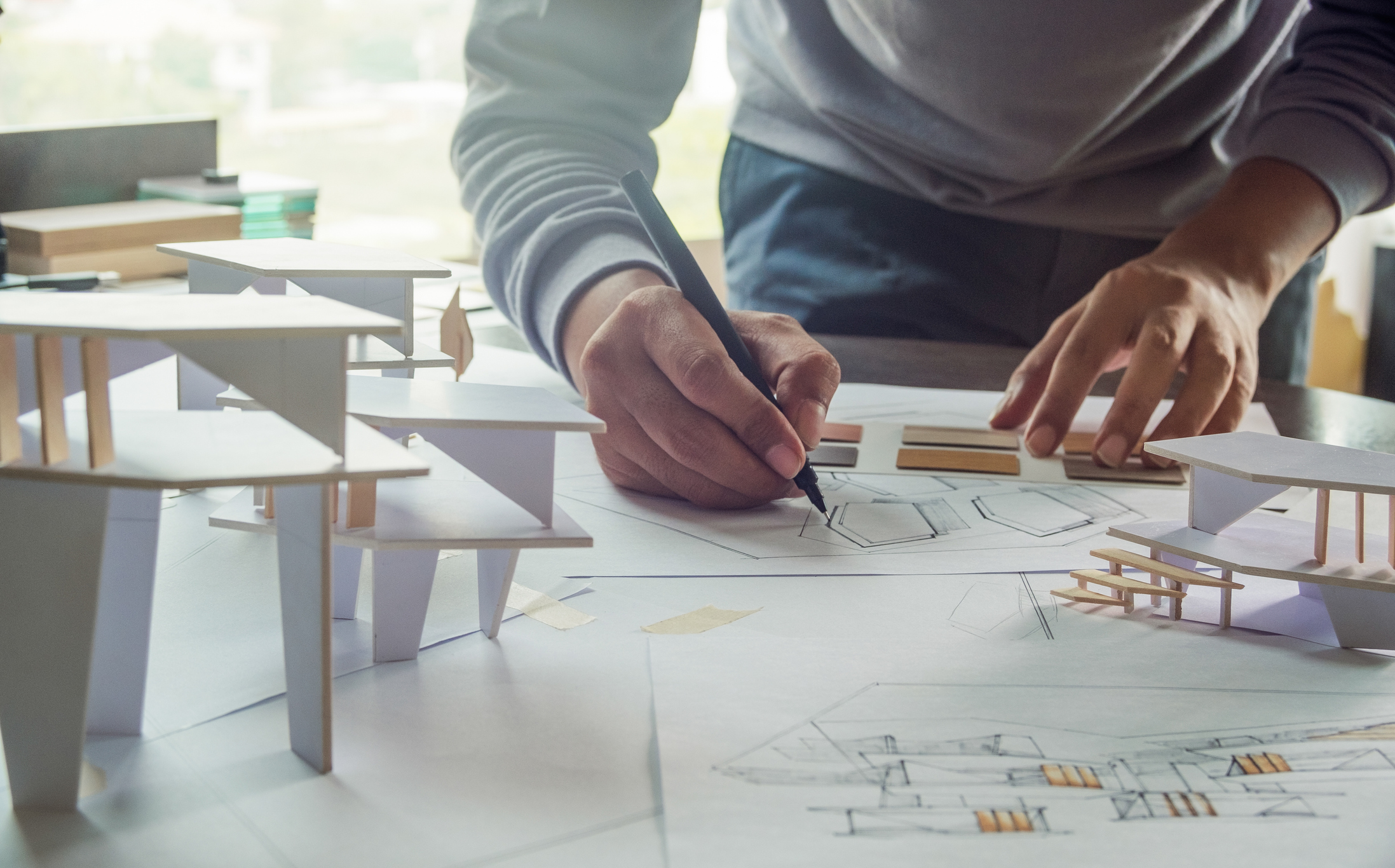Architect Firm Identity Strategies That Get Noticed
Architect Firm Identity Strategies That Get Noticed
Blog Article
Recognizing the Diverse Career Paths Available for Aspiring Architect
As an aspiring Architect, you have a world of occupation courses waiting for you. Whether you're attracted to conventional design or the subtleties of lasting layout, there's a niche that lines up with your rate of interests.
Typical Architecture: Designing Structures and Frameworks
Traditional architecture focuses on developing buildings and structures that blend performance with aesthetic charm. Your styles can mirror cultural heritage, showcasing local customs while meeting contemporary needs.
You'll create abilities in composing, model-making, and website analysis, enabling you to imagine and interact your ideas efficiently. Engaging with customers, you'll need to understand their vision and convert it right into possible designs.
In addition, constructing codes and sustainability methods are necessary in your work, guaranteeing your structures are ecologically friendly and risk-free. As you grow in your job, you'll discover opportunities in residential, business, or even reconstruction jobs, each offering distinct challenges. Accepting traditional style paves the means for a satisfying career that admires the past while shaping the future.
Urban Preparation: Shaping Areas and Public Spaces
As a hopeful Architect, you can play a crucial role as an urban planner, transforming exactly how communities work and engage. By utilizing neighborhood engagement methods, you'll guarantee that locals have a voice in forming their setting. And also, integrating sustainable style concepts will certainly help create spaces that not just fulfill today's demands but likewise safeguard the future.
Function of Urban Planners
While lots of could believe of architects as the sole dreamers behind buildings, city planners play a crucial duty in shaping the wider landscape of neighborhoods and public spaces. By teaming up with numerous stakeholders, you'll help develop parks, transport systems, and household areas that promote social communication and availability. Your expertise in spatial layout and neighborhood dynamics allows you to imagine future development while preserving cultural heritage.
Area Interaction Techniques
Efficient area involvement strategies are essential for metropolitan coordinators to guarantee that the voices of residents are heard and valued in the preparation procedure. To cultivate significant discussion, you should focus on open online forums and workshops where neighborhood participants can express their concepts and problems. Use studies and social media to reach a wider audience, making certain diverse perspectives are consisted of. Working together with neighborhood companies can boost trust fund and promote deeper links. It's crucial to supply clear information about proposed jobs and decision-making processes, allowing residents to feel informed and equipped. By actively paying attention and incorporating comments, you'll produce areas that mirror the community's needs, ultimately resulting in more effective and sustainable urban settings. Accept openness and continual discussion for long lasting impact.
Lasting Layout Concepts
When making urban areas, including sustainable design concepts is crucial for developing environments that prosper both ecologically and socially. You must begin by concentrating on power performance, using materials that reduce waste and advertise recycling. Consider integrating environment-friendly rooms, like parks and yards, to improve biodiversity and improve air quality. Advertising walkability and public transportation can lessen reliance on cars and trucks, fostering a healthier area.
Designing with water conservation in mind is additionally vital-- think about rain yards and permeable surfaces to take care of stormwater. Including neighborhood participants throughout the planning procedure warranties that the areas you create satisfy their requirements and motivate social communication. By embracing these principles, you'll add to lively, lasting urban landscapes that profit everyone.

Landscape Style: Developing Lasting Outside Environments
As you check out landscape architecture, you'll uncover vital style concepts that produce stunning and practical outdoor areas. Sustainable techniques play a vital duty in making sure these environments prosper while reducing environmental impact. And also, you'll locate a range of occupation chances that enable you to make a real difference in just how individuals connect with nature.
Style Concepts in Landscape
Comprehending design concepts in landscape style is important for developing sustainable outside settings that harmonize with nature. You'll require to ponder elements like balance, proportion, and scale to guarantee your layouts really feel cohesive and inviting. Integrating indigenous plants not just enhances biodiversity yet also lowers water usage, making your landscape resistant. Consider the circulation of area and exactly how people engage with it; pathways and seating areas should invite exploration and relaxation. In addition, take note of seasonal adjustments, designing with materials that match the environments year-round (Architect). By prioritizing sustainability and visual appeals, you can produce exterior spaces that improve the community and promote wellness. Accepting these concepts will certainly establish a strong structure for your job in landscape design.
Lasting Practices Review
Lasting techniques in landscape style not only focus on visual appeals however additionally focus on ecological health and resource preservation. You can make rooms that promote soil health, such as utilizing natural products and exercising permaculture concepts. Inevitably, these techniques guarantee your designs benefit both people and the environment for years to come.
Career Opportunities Exploration
With a strong foundation in sustainable methods, landscape design uses a selection of job courses that permit you to make a significant effect on the setting. You could work as a landscape designer, creating aesthetically pleasing and practical outdoor rooms, or concentrate on eco-friendly restoration, helping to revitalize broken ecological communities. Urban organizers usually team up with landscape designers to produce eco-friendly areas in urban settings, boosting city livability. If you're enthusiastic regarding education and learning, take into consideration coming to be a landscape style instructor, motivating future generations. Furthermore, you may work with nonprofits focused on ecological sustainability or involve in research study to introduce new practices. Each course not just shapes lovely environments but likewise promotes a healthier earth for future generations.
Lasting Style: Concentrating on Eco-Friendly Practices
As you explore your occupation in architecture, welcoming environmentally friendly techniques can set you apart in an affordable field. Sustainable layout focuses on producing buildings that lessen environmental influence while improving occupant well-being. By including sustainable products, energy-efficient systems, and lasting structure strategies, you'll contribute to a greener future.
Begin by obtaining knowledge of eco-friendly qualifications like LEED or BREEAM, which can bolster your credentials. this website Think about just how natural light, ventilation, and thermal effectiveness can maximize design. Work together with designers and environmental specialists to introduce remedies that reduce waste and save sources.
Do not forget the importance of neighborhood participation-- interesting regional stakeholders can motivate designs that harmonize with the setting. As clients increasingly prioritize sustainability, your knowledge in green techniques will certainly not just attract projects but also fulfill your passion for responsible style. Welcome this crucial aspect of the career, and see your job prosper.
Historical Preservation: Safeguarding and Restoring Cultural Heritage
While you start on your building journey, consider the essential role of historical preservation in preserving our cultural heritage. This area concentrates on the security and repair of considerable buildings, websites, and frameworks that tell the stories of our past. By involving in historical preservation, you'll help protect the architectural heritage that shapes community identity.
As a historic conservation Architect, you'll examine historical value and examine the condition of structures. You'll function carefully with conservationists and historians to assure authentic reconstruction methods are used. This profession course enables you to mix creativity with study, enabling you to make services that value original products and workmanship.
Your work not just adds to sustainability by reusing existing structures yet also cultivates a feeling of satisfaction within neighborhoods. Welcoming this path will aid you end up being a guardian of history, protecting the tales and aesthetic appeals that enrich our lives.
Inside Style: Enhancing Indoor Spaces
Historic preservation and interior design both share a dedication to enhancing the built environment, yet they concentrate on different aspects. While historical preservation highlights keeping a structure's historic and social worth, interior design absolutely nos in on optimizing interior spaces for capability and aesthetic appeals.
As an aspiring Architect, you'll discover that indoor style allows you to mix imagination with technical skills. You'll create areas that not just look excellent yet additionally promote comfort and effectiveness. This field includes recognizing just how light, color, and products connect within a room, influencing state of mind and use.
You'll deal with numerous jobs, from residential homes to commercial workplaces, ensuring that each atmosphere satisfies the needs of its passengers. By focusing on individual experience, you can change interiors into useful and inspiring areas, making a significant effect on exactly how individuals connect with their environments. Embrace the opportunity to improve indoor environments and form the method individuals work and live.
Industrial Design: Merging Performance With Visual Appeals
Commercial design plays a vital role in producing items that effortlessly mix visual appeals with capability, making certain that what you use day-to-day is not only visually appealing but also useful. As an ambitious Architect, you can engage yourself in this field, focusing on designing every little thing from furnishings to customer electronic devices. Your work includes understanding customer requirements, materials, and producing processes, permitting you to produce innovative remedies that improve everyday experiences.
In industrial design, you'll often work together with marketing professionals, suppliers, and engineers, making sure that your designs are not just gorgeous but likewise feasible. You'll find out to balance kind and feature, prioritizing functionality without sacrificing style. By developing your abilities in sketching, 3D modeling, and prototyping, you'll be fully equipped to bring your ideas to life. This job path uses a dynamic setting where imagination fulfills practicality, making it i loved this a rewarding choice for designers curious about forming the products of tomorrow.
Often Asked Questions
What Educational Certifications Do I Need to End Up Being an Engineer?
To come to be a designer, you'll need a professional level in style, typically a Bachelor's or Master's. Furthermore, you'll need to complete an internship and pass the Architect Registration Assessment to practice legally.
Are There Certification Needs for Various Building Job Paths?
Yes, there're qualification demands for different building paths. Architect. You'll need to pass tests, total internships, and occasionally pursue specialized training, depending on your picked emphasis, like landscape style, urban style, or historical preservation
What Software Program Abilities Are Vital for Engineers Today?

Just How Can I Gain Practical Experience While Examining Design?
You can get sensible experience by interning at building companies, joining design competitions, volunteering for neighborhood jobs, or collaborating with classmates on real-world assignments. These chances improve your abilities and construct important connections in the sector.
What Task Opportunities Exist Outside Traditional Architecture Firms?
You can discover different task chances outside typical design firms, like city planning, interior decoration, landscape style, construction management, realty development, or also roles in sustainability consulting. Each offers one-of-a-kind challenges and rewards.
Whether you're drawn to standard style or the subtleties of lasting layout, there's a niche that lines up with your interests.When designing metropolitan rooms, including sustainable layout concepts is important for creating settings that grow both ecologically and socially.As you check out landscape design, you'll uncover important style concepts that develop beautiful and useful exterior spaces.Comprehending style concepts in landscape style is important for producing sustainable outdoor atmospheres that integrate with nature.In commercial layout, you'll often team up with marketers, designers, and makers, guaranteeing that your layouts are not just lovely yet also feasible.
Report this page